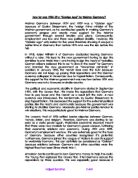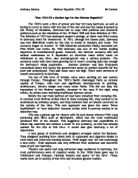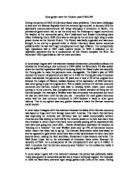The political and economic stability in Germany started in September 1924, with the Dawes Plan. This made the reparations that Germany had to pay lower and the French as a result left the Ruhr. A new currency was introduced, the Rentenmark, by Gustav Stresemann to stop hyperinflation. This decreased the support for the extremist political parties, like the Nazi’s and communists because the government was starting to stabilize Germany. Moderate pro-Weimar parties tended to win elections. This was particularly good for Weimar Germany.
The Locarno Pact of 1925 settled border disputes between German, France, Britain, and Belgium. Therefore, Germany was starting to be seen as a world power again. Worldwide economic recovery meant that there were new markets for Germany’s goods abroad, furthering their economic relations and economy. During 1924 and 1929, Germany’s employment was low. This was extremely good for the face of Germany because other countries recognised it’s potential. Furthermore, Germany joined the League of Nations to add its support to worldwide harmony. This can definitely be considered as “Golden” because relations between Germany and other countries were the highest they had been Since World War 1.
American banks continued to loan Germany money to help it re-build. The Young Plan replaced the Dawes Plan. It let Germany reduce the reparations by three quarters. This was especially good because it meant Germany could focus on building its economy. Before 1924, Germany was focused on paying reparations, which were the main reason why the French invaded the Ruhr.
This shows that 1924 to 1929 was a “Golden age” to a large extent because everyone was living to a higher standard than before without rebellions or mass demonstrations against the Weimar government. However, the Nationalists criticized the Dawes Plan as they considered it the “second Treaty of Versailles.” The Young Plan also was not liked, because of its decisiveness about the reparations. Some Germans believed Germany should not have been forced to pay any reparations at all. The Locarno treaty had several faults, one of which was its failure to secure Germany’s Eastern borders as well as her Western ones. This could cause resentfulness in Russo-German relations and thus exposing the Rapallo Treaty.
Even though, initially during this period of time, Germany seemed to have started building up their wealth, the money was a loan from America and therefore at some point America would want that money back. When this happens, which it did due to the Wall Street Crash in 1929, Germany would have to pay back all the loans. This would mean the stability in the economy during 1924 to 1929 was a result of American loans rather than German efficiency.
The mid twenties were a period of increased stability for Germany. People were better off than they had been in the first 4 years of the new government and were better off than they were in the 3 years following the Wall Street Crash, however, compared with other countries, such as the USA, Britain and France the Weimar republic was still a poor relation. In addition, it was the “Golden age” to a large extent because there was plenty of support for the Weimar government and they may have succeeded to bring Germany back up if Gustav Stresemann had not died in 1929 and if Germany had not been forced to pay back the loans from America so quickly.







